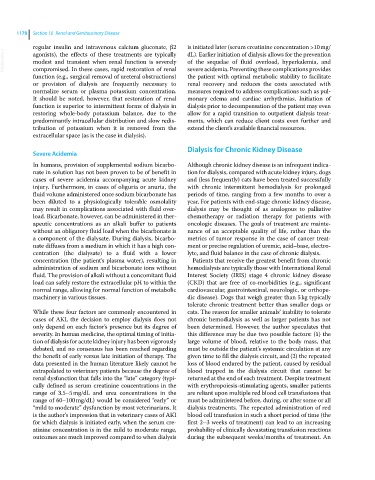Page 1240 - Clinical Small Animal Internal Medicine
P. 1240
1178 Section 10 Renal and Genitourinary Disease
regular insulin and intravenous calcium gluconate, β2 is initiated later (serum creatinine concentration >10 mg/
VetBooks.ir agonists), the effects of these treatments are typically dL). Earlier initiation of dialysis allows for the prevention
of the sequelae of fluid overload, hyperkalemia, and
modest and transient when renal function is severely
compromised. In these cases, rapid restoration of renal
the patient with optimal metabolic stability to facilitate
function (e.g., surgical removal of ureteral obstructions) severe acidemia. Preventing these complications provides
or provision of dialysis are frequently necessary to renal recovery and reduces the costs associated with
normalize serum or plasma potassium concentration. measures required to address complications such as pul-
It should be noted, however, that restoration of renal monary edema and cardiac arrhythmias. Initiation of
function is superior to intermittent forms of dialysis in dialysis prior to decompensation of the patient may even
restoring whole‐body potassium balance, due to the allow for a rapid transition to outpatient dialysis treat-
predominantly intracellular distribution and slow redis- ments, which can reduce client costs even further and
tribution of potassium when it is removed from the extend the client’s available financial resources.
extracellular space (as is the case in dialysis).
Dialysis for Chronic Kidney Disease
Severe Acidemia
In humans, provision of supplemental sodium bicarbo- Although chronic kidney disease is an infrequent indica-
nate in solution has not been proven to be of benefit in tion for dialysis, compared with acute kidney injury, dogs
cases of severe acidemia accompanying acute kidney and (less frequently) cats have been treated successfully
injury. Furthermore, in cases of oliguria or anuria, the with chronic intermittent hemodialysis for prolonged
fluid volume administered once sodium bicarbonate has periods of time, ranging from a few months to over a
been diluted to a physiologically tolerable osmolality year. For patients with end‐stage chronic kidney disease,
may result in complications associated with fluid over- dialysis may be thought of as analogous to palliative
load. Bicarbonate, however, can be administered in ther- chemotherapy or radiation therapy for patients with
apeutic concentrations as an alkali buffer to patients oncologic diseases. The goals of treatment are mainte-
without an obligatory fluid load when the bicarbonate is nance of an acceptable quality of life, rather than the
a component of the dialysate. During dialysis, bicarbo- metrics of tumor response in the case of cancer treat-
nate diffuses from a medium in which it has a high con- ment or precise regulation of uremic, acid–base, electro-
centration (the dialysate) to a fluid with a lower lyte, and fluid balance in the case of chronic dialysis.
concentration (the patient’s plasma water), resulting in Patients that receive the greatest benefit from chronic
administration of sodium and bicarbonate ions without hemodialysis are typically those with International Renal
fluid. The provision of alkali without a concomitant fluid Interest Society (IRIS) stage 4 chronic kidney disease
load can safely restore the extracellular pH to within the (CKD) that are free of co‐morbidities (e.g., significant
normal range, allowing for normal function of metabolic cardiovascular, gastrointestinal, neurologic, or orthope-
machinery in various tissues. dic disease). Dogs that weigh greater than 5 kg typically
tolerate chronic treatment better than smaller dogs or
While these four factors are commonly encountered in cats. The reason for smaller animals’ inability to tolerate
cases of AKI, the decision to employ dialysis does not chronic hemodialysis as well as larger patients has not
only depend on each factor’s presence but its degree of been determined. However, the author speculates that
severity. In human medicine, the optimal timing of initia- this difference may be due two possible factors: (1) the
tion of dialysis for acute kidney injury has been vigorously large volume of blood, relative to the body mass, that
debated, and no consensus has been reached regarding must be outside the patient’s systemic circulation at any
the benefit of early versus late initiation of therapy. The given time to fill the dialysis circuit, and (2) the repeated
data presented in the human literature likely cannot be loss of blood endured by the patient, caused by residual
extrapolated to veterinary patients because the degree of blood trapped in the dialysis circuit that cannot be
renal dysfunction that falls into the “late” category (typi- returned at the end of each treatment. Despite treatment
cally defined as serum creatinine concentrations in the with erythropoiesis‐stimulating agents, smaller patients
range of 3.5–5 mg/dL and urea concentrations in the are reliant upon multiple red blood cell transfusions that
range of 60–100 mg/dL) would be considered “early” or must be administered before, during, or after some or all
“mild to moderate” dysfunction by most veterinarians. It dialysis treatments. The repeated administration of red
is the author’s impression that in veterinary cases of AKI blood cell transfusion in such a short period of time (the
for which dialysis is initiated early, when the serum cre- first 2–3 weeks of treatment) can lead to an increasing
atinine concentration is in the mild to moderate range, probability of clinically devastating transfusion reactions
outcomes are much improved compared to when dialysis during the subsequent weeks/months of treatment. An

